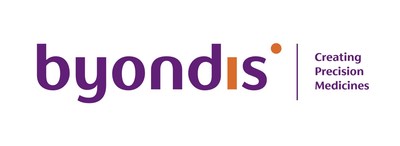Study Meets Primary Endpoint, Confirming the ADC [Vic-]Trastuzumab Duocarmazine is Superior to Physician’s Choice in Delaying Disease Progression
Study Meets Primary Endpoint, Confirming the ADC [Vic-]Trastuzumab Duocarmazine (SYD985) is Superior to Physician’s Choice in Delaying Disease Progression
NIJMEGEN, Netherlands, June 8, 2021 -- Byondis B.V. today announced positive topline results from the Phase III TULIP® study, a multi-center, open-label, randomized clinical trial. The trial compared the efficacy and safety of the company’s antibody-drug conjugate (ADC) [vic-]trastuzumab duocarmazine (SYD985) to physician’s choice treatment in patients with pretreated HER2-positive unresectable locally advanced or metastatic breast cancer (MBC).
The Phase III TULIP study “SYD985 vs. Physician’s Choice in Participants With HER2-positive Locally Advanced or Metastatic Breast Cancer” met its primary endpoint of progression-free survival (PFS), demonstrating a statistically significant improvement over physician’s choice. PFS is defined as the time from the date of randomization to the date of first documented disease progression or death due to any cause, whichever occurred earlier. The study also demonstrated preliminary supportive overall survival (OS) results.
“There is considerable unmet medical need in patients with HER2-positive metastatic breast cancer and [vic-]trastuzumab duocarmazine represents a promising potential clinical advance,” said Byondis Chief Medical Officer Jan Schellens, M.D., Ph.D. “We are excited by the topline results of TULIP and indebted to all patients who participated in the clinical studies.”
Byondis CEO Marco Timmers, Ph.D., referred to the study’s culmination as a triumph over adversity. “A large trial involving breast cancer patients with advanced disease is difficult in the best of times, but it is especially challenging during a global pandemic. The completion of TULIP is a testament to the dedication of all involved, especially the patients, their families and participating clinical sites.”
Detailed results from TULIP will be published at scientific conferences in due course. Byondis will complete the biological license application (BLA) and intends to submit it before the end of 2021.
With this positive study outcome, Byondis is planning to explore partnerships with pharma and biopharma companies in order to commercialize SYD985 and make it available to patients in need of new treatment options.
SYD985 was granted fast track designation by the U.S. Food & Drug Administration in January 2018 based on promising data from heavily pre-treated last-line HER2-positive MBC patients participating in a two-part Phase I clinical trial (SYD985.001).[1]
About TULIP (SYD985.002)
Begun in November 2017, TULIP enrolled a total of 436 female patients aged 18 and over, at 83 sites across the United States, Canada, Europe and Singapore. To qualify, patients had either: (1) progression during or after at least two HER2-targeting treatment regimens for locally advanced or metastatic disease; or (2) progression during or after ado-trastuzumab emtansine treatment. Patients were randomly assigned (2:1) to receive SYD985 or physician’s choice treatment until disease progression or unacceptable toxicity.
In addition to blinded, independent, centrally reviewed PFS, the trial’s secondary objectives were to compare the two treatment groups with respect to: (1) overall survival (OS); (2) objective response rate (ORR) on the basis of the blinded independent central review; (3) investigator-assessed PFS; (4) patient-reported outcomes (PRO) for health-related quality of life; and (5) safety and tolerability.
[Vic-]Trastuzumab Duocarmazine (SYD985), a Next Generation Antibody-Drug Conjugate
[Vic-]trastuzumab duocarmazine (SYD985) incorporates Byondis’ distinctive, proprietary duocarmazine linker-drug (LD) technology ByonZine®. Although in general, marketed ADCs have improved therapeutic indices compared to classical non-targeted chemotherapeutic agents, there is still need for improvement.
The ADC [vic-]trastuzumab duocarmazine is comprised of the monoclonal antibody trastuzumab and a cleavable linker-drug called valine-citrulline-seco-DUocarmycin-hydroxyBenzamide-Azaindole (vc-seco-DUBA). The antibody part of [vic-]trastuzumab duocarmazine binds to HER2 on the surface of the cancer cell and the ADC is internalized by the cell. After proteolytic cleavage of the linker, the inactive cytotoxin is activated and DNA damage is induced, resulting in tumor cell death. SYD985 is considered a form of targeted chemotherapy.
[Vic-]trastuzumab duocarmazine is currently being investigated in four other studies. Byondis initiated a Phase II clinical trial in HER2-expressing recurrent, advanced or metastatic endometrial cancer and a Phase I study exploring the synergistic effects of [vic-]trastuzumab duocarmazine and niraparib in patients with HER2-expressing locally advanced or metastatic solid tumors. [Vic-]trastuzumab duocarmazine is also part of two Quantum Leap Health Collaborative™ trials: a new arm of the I-SPY 2 TRIAL™ investigating the neoadjuvant use of [vic-]trastuzumab duocarmazine in HER2-low early-stage breast cancer; and a Phase I combination trial with paclitaxel in solid tumors.
ByonZine®, Byondis’ Distinctive, Proprietary Linker-Drug Technology
While earlier generation ADCs improved targeting and cell killing, they were unstable in the bloodstream, leading to premature release of the cytotoxic payload, impacting healthy tissue and narrowing the therapeutic window. Byondis’ next generation ADCs are highly stable in circulation and carry an intricate, inactivated and potent cytotoxic drug that rapidly self-destructs in case it is prematurely released, limiting damage to healthy tissue and improving the therapeutic window.
Byondis’ differentiated linker-drug, vc-seco-DUBA, owes its potent antitumor activity to a synthetic duocarmycin-based cytotoxin. Duocarmycins, first isolated from Streptomyces bacteria in the 1970s, bind to the minor groove of DNA and disrupt the nucleic acid architecture, which eventually leads to tumor cell death.
The distinctive design of the selectively cleavable linker connecting the antibody to the duocarmycin drug leads to high stability in circulation and induces efficient release of the cytotoxin in the tumor. Uptake of the activated payload by neighboring tumor cells with lower HER2 expression may improve the efficacy potential, the so-called bystander effect.
HER2-Positive MBC: A Cancer With a Poor Prognosis
Breast cancer was the world’s most common cancer in 2020,[2] with an estimated 2.3 million new cases.[3] Its incidence is rising, particularly in developing countries, where the majority of cases are diagnosed in late stages.[4] Breast cancer is the leading cause of cancer death for women in over 100 countries.[5]
In metastatic or Stage 4 breast cancer, the cancer spreads to other parts of the body, such as the lungs, liver, bones or brain. Approximately 0.5 million people worldwide die from MBC every year.[6]
In HER2-positive breast cancer, an overexpression of the human epidermal growth factor receptor 2 (HER2) protein causes out-of-control reproduction of breast cells. Research has shown that women with HER2-positive breast cancer have a more aggressive disease, greater likelihood of recurrence and poorer prognosis, compared to women with HER2-negative breast cancer. About 20 percent of all breast cancers are HER2-positive, with younger women being the most affected. Treatment of HER2-positive breast cancer can consist of the following: surgery, radiation, chemotherapy and targeted treatments.[7]
About Byondis
Driven to improve patients’ lives, Byondis is an independent, privately held, clinical stage biopharmaceutical company creating innovative precision medicines targeting intractable cancers and autoimmune diseases. The company is developing new biological entities (NBEs) and new chemical entities (NCEs) using proprietary molecular concepts, such as ByonZine®, its duocarmazine linker-drug (LD) technology, and ByonShieLD®, its site-specific conjugation technology, to generate next generation antibody-drug conjugates (ADCs).
Byondis’ broad development portfolio comprises preclinical as well as early- and late-stage clinical programs. The company has a dedicated team of about 400 employees, including highly educated scientists and skilled technicians working in state-of-the-art R&D and Good Manufacturing Practice manufacturing facilities on its Nijmegen campus in the Netherlands. Byondis regularly collaborates with leading, global biotechnology and pharmaceutical companies, as well as many academic research institutions. For more information, visit www.byondis.com.
The TULIP study (SYD985.002) is registered in ClinicalTrials.gov with identifier NCT03262935.
[1] Banerji, Udai, et al. “Trastuzumab Duocarmazine in Locally Advanced and Metastatic Solid Tumours and HER2-Expressing Breast Cancer: a Phase 1 Dose-Escalation and Dose-Expansion Study.” The Lancet Oncology, Elsevier, 27 June 2019, www.sciencedirect.com/science/article/pii/S1470204519303286.
[2] “Cancer.” World Health Organization, World Health Organization, 3 Mar. 2021, www.who.int/news-room/fact-sheets/detail/cancer.
[3] Sung H;Ferlay J;Siegel RL;Laversanne M;Soerjomataram I;Jemal A;Bray F; “Global Cancer Statistics 2020: GLOBOCAN Estimates of Incidence and Mortality Worldwide for 36 Cancers in 185 Countries.” CA: a Cancer Journal for Clinicians, U.S. National Library of Medicine, May 2021, www.pubmed.ncbi.nlm.nih.gov/33538338/.
[4]"Breast Cancer: Prevention and Control.” World Health Organization, World Health Organization, 21 Jan. 2016, www.who.int/cancer/detection/breastcancer/en/.
[5] “Metastatic Breast Cancer: a Major and Growing Burden.” UICC, 2 July 2019, www.uicc.org/what-we-do/capacity-building/grants-and-fellowships/sparc-grants/metastatic-breast-cancer-major-and.
[6] Cardoso F;Spence D;Mertz S;Corneliussen-James D;Sabelko K;Gralow J;Cardoso MJ;Peccatori F;Paonessa D;Benares A;Sakurai N;Beishon M;Barker SJ;Mayer M; “Global Analysis of Advanced/Metastatic Breast Cancer: Decade Report (2005-2015).” Breast (Edinburgh, Scotland), U.S. National Library of Medicine, 19 Apr. 2018, www.pubmed.ncbi.nlm.nih.gov/29679849/.
[7] Madell, Robin. “HER2 Breast Cancer: What Is It, Treatment, and More.” Healthline.com, 14 Dec. 2020, www.healthline.com/health/breast-cancer/her2-positive-survival-rates-statistics.





